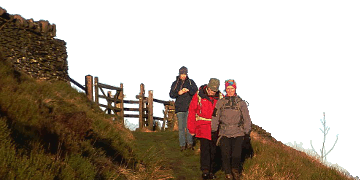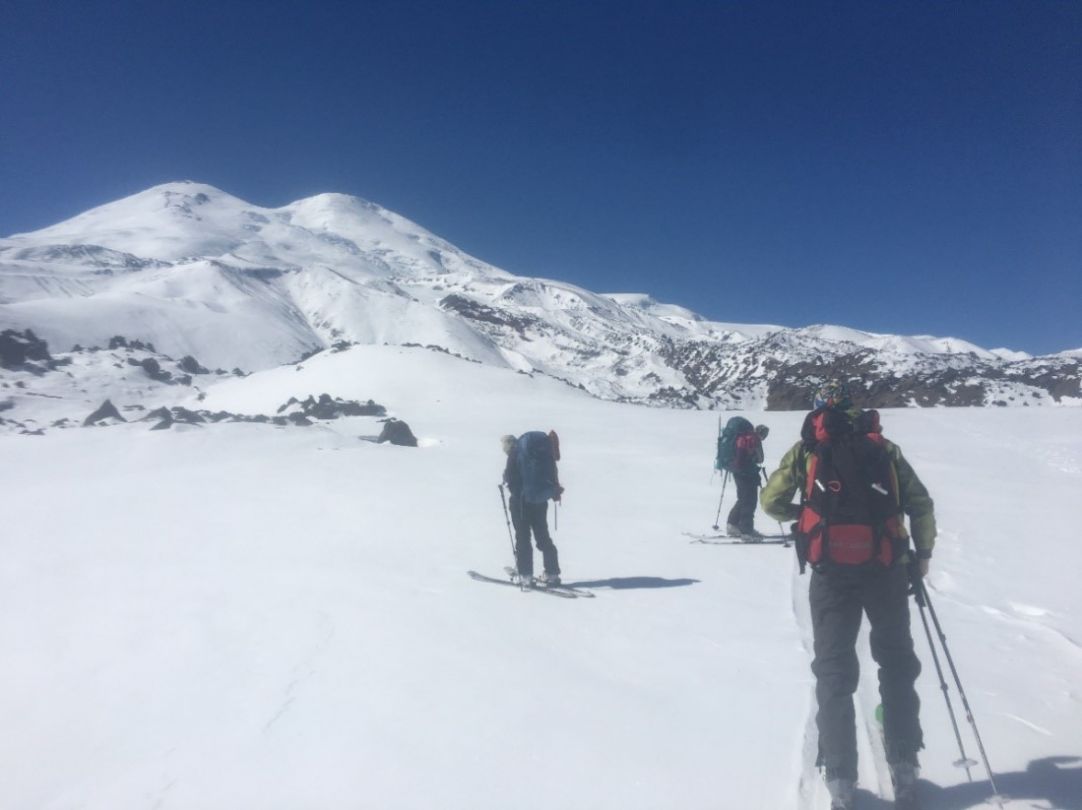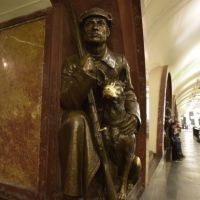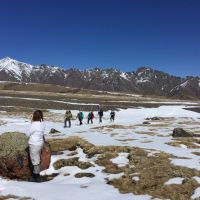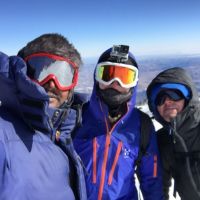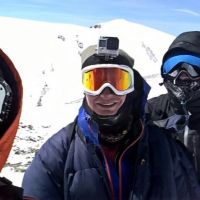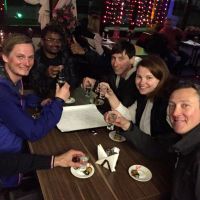Ski-humping in Russian Caucasian Mountains
By Mark Pilling
With my daughter approaching school age & therefore holiday time now becoming something of a rarity, I decided to go big and sign up with a tour group expedition for a ski-tour ascent of Mount Elbrus (5642m) in the Russian Caucasian mountains, on the border with Georgia, via a Northern approach in the Winter months (April). Elbrus is one of the “Seven Summits”, is Europe’s highest summit and is an extinct volcano with a distinctive double summit shape. The mountain is usually ascended from the South side, where there is a ski resort with lifts, which can take you to 3900m, and in the summer, Snowcats can take you even to 5100m, minimising the ascent. However on the North side & face, there is minimal infrastructure. The passes are frequently closed by snow, and you need to hike at least 15km across tundra and steep scree paths to reach an isolated base camp (2600m). A further 12km away is a basic high camp at 3800m, at the foot of the glaciers. So I thought that sounded much more adventurous!
Before being able to get a visa to visit Russia, you need a letter of introduction from a Russian travel agent. This enables you to apply for a visa by attending an interview at one of their embassies (Manchester or London) when they take your fingerprint. The visa also needs to detail when & where you will be staying at all times. And of course the language & alphabet mean that it is very hard to understand any of the signs when you are there. So the logistics of a trip are much easier to deal with via a tour company.
Day 1: I booked a flight with the national carrier Aeroflot (as they take your skis/boots for free) from Heathrow to Moscow, which only took a 3.5h flight, and then had 30h to explore the city before catching a transfer to Mineralyne Vody. Baggage can be stored at the airport, allowing an easy transfer into Moscow for an overnight stay. Moscow was totally amazing, with so many sights to see as well as lots of singing & food preceding Easter; Lenin’s tomb, the Romanov’s house, St Peters Basilica, Gagarin monument etc.. It was also the 100th anniversary of the October Revolution, but today’s Russian government was keeping that date low-key. As Lenin was out of his tomb having his bi-annual makeover, so I took some walking tours and saw the heroes of the revolution at Ploshchad Revolyutsii Station. Definitely a place to come back to.
Day 2: The next day I flew to the smaller airport of Mineralyne Vody (which means “Mineral Water”) & then we transferred to the city of Kislovodsk 2h away. Exploring the city, this is mainly a tourist spa-town renowned for its healthy waters. I met our head guide Viktor as well as the others on this trip; there were four ski tourers - Pierre (an ultra-runner from Belgium), Sasha & Marina from Kamchatka & myself. There was also a group of four walkers; Paul & Yuli (St Petersburg), Sebastian (ex-marine from Denmark) & Mani (an Indian living in the UAE). My ski-touring group looked particularly strong, so I wished I’d put more hours in on the cross-trainer! There was a full kit inspection & a lot of our group needed to hire rucksacks (75L), parkers, crampons, and boots. Thermos… I had most of the gear already & was trying to go ultra-light, but I still hired the biggest gaiters I have ever seen - which fitted over the top of my touring boots. The assistant guides Sasha & Anton explained the mountain conditions were very variable, & that at this time of year there is no rescue team on the mountain. Surprising everyone, somehow I managed to pack everything, including skis, into/onto my 40L rucksack ready for the morning. A team meal of traditional shisha-ribs sealed off the day & allowed us to get to know each other.
Day3: There was an excellent road for the 3h drive towards the mountain, although I was slightly concerned that Elbrus never seemed to get any closer. Having decided to go light, I did not take extra walking boots & so (with Pierre) we had to hike in ski-touring boots. Which was a mistake.
The area is strikingly beautiful, grassy tundra and valleys/passes, but also rather empty & barren in places with not much wildlife – possibly because of the hard winters. The winter had also led to one of the passes being blocked by snow (even stopping 4WD rescue vehicles), so we had to depart the vehicles early for our 15-20km hike to base camp. Pierre & the dynamic Russian women quickly disappeared into the distance, whilst I went at a slower pace & stayed with the walkers in the blazing heat – whilst also trying to keep snow from going over the top of my boots in some places! Basecamp was friendly collection of buildings built above the permafrost, with a lot of dogs & a canteen. It looked like leg-power or a helicopter was the only way to bring all supplies there. The handful of staff there were great, and some of them had already spent the previous week shuttling up loads to the high camp. So we enjoyed a healthy meal (borscht) & then settled into a hut with a diesel-powered stove to keep us warm through the night (everything placed on the ground in the hut froze).
Day 4: Today was for us to porter part of our equipment to high camp, with the walkers starting at 8am & the tourers at 9am. Another hot & blue-sky day meant it was very warm work to carry our skis the 12km to high camp, but we quickly caught up the walkers. Yuli in particular seemed to not have anticipated how hard this kind of trip would be, whilst Mani (who had recently trekked to Everest basecamp) was not expecting the heavy loads & winter mountaineering dimension to the trip! It was a brutal grind up snow & scree slopes that day, past a field used by the Nazis as an airstrip, up to the exposed high camp – taking 6h. Again, there was lots of golden grass & purple flowers lower down to give some colour to the landscape. But I should definitely have taken more than 1L of water on the hike, as I was expecting water to be available at the empty camp!! This day also gave us the chance to practise our ski touring, as there were larger sections of snow that allowed us 1.5h of touring. The guide Sasha said that the conditions here could change very rapidly, so that more touring might be possible later in the trip & so it was worth taking all our equipment up.
The current mountain conditions were currently too icy, they said, for ski-touring above high camp – but we hoped that would improve. We also heard that 2 week previously a ski-tourer had fallen on the decent & broken their ankle and needing a helicopter rescue – which might explain the guide’s caution. Additionally the previous week two climbers on the south side had been hit by rock fall, with one being killed. Back at the basecamp 2h later, the group decided to have a “Banya” to relax. This was especially popular with the Danish Sebastian, & involved getting naked in a steam room (apart from wool caps), hitting each other with wet branches, having a cold rinse from a bucket, & then repeating! When in Russia…
Day 5: The weather was again very settled & hot, but was still hard work to the top. The walkers had dumped their gear near a cave at 3500m so still needed to carry equipment the last distance to high base camp where we were to stay for the next quiet 3 nights. Arriving after 4h of hiking, we were housed in a windowless octagonal tin with seven double sleeping spaces. Some of the friendly dogs from basecamp also decided to come along! At this location, the mountain looks quite near & the ice fields start – with a few small crevasses apparent. Only vertical 2km to the top! When the walkers arrived we had our evening meal (all coloured green by the canteen’s corrugated skylight) & we settled down for the night – unfortunately there was only enough fuel for a small part of the night in the brazier, which liked to puff & blow snow rings everywhere. I had a poor night’s sleep due to a loud storm & it being much colder than basecamp. Snow goggles were need to get to the loos, which were airy as the doors had been blow off. This was certainly feeling more adventurous.
Day 6: It had been a noisy, cold night in the tin can. In fact, the adjacent compartment had been breached by the storm & filled with spindrift during the night with all our water bottles freezing. Today was an acclimatization day, going up to point 4700 (+900m). It was snow goggles weather with intermittent blizzards & sun with fresh snow on hard neve ice. Although the dogs seemed to like it & were jumping through the lower snowfields! Unfortunately, there was not enough snow to allow ski touring so we were a walking group today. The guides were ultra-careful, insisting on roping us up in camp & fixing ropes over the crevassed sections of the ice field (even though they appeared <0.5m wide). I wore my monster-sized gaiters, which proved surprisingly hard to securely attach crampons over. In fact, we only managed to get to point 4500 due to the weather, and it was surprisingly exhausting for me to keep up with the Russian dynamic duo & the ultra-runner I was roped to! So I needed to conserve my strength for the summit day. And now I wished I had brought my long walking axe rather than a short/light ski-touring axe.
When we got back to camp, the food was great with lots of green/black tea, but unfortunately, a lack of fuel meant there were no lights/heating in the canteen, with my pen & water bottles again freezing. Using hot water in a thermos is necessary in the high mountains, & I wished I’d brought more than my 0.5L bottle. We also found that the walking team had enjoyed their first taste of using crampons, although Yuli had decided not to acclimatise/attempt the summit, and Mani had fallen into a crevasse. Twice! He later showed me his goggles & complained they kept steaming up. No one had previously noticed that he had accidentally brought sealed safety goggles, not snow goggles! Fortunately, Yuli offered him the use of her goggles for the ascent day.
Day 7: Rest day. It was another stormy night, with 100km/h winds hitting the tin can where we slept, more spindrift & everything freeing. Even trying to get to the loo was crazy, & it was wise to team-up up with someone to avoid getting lost on the way. The weather meant we could not practise ski-touring skills, & I was concerned that my Scotland-blunted crampons needed sharpening for the hard ice – so spent a couple of hours filing sharp points back on them all, a very wise choice. I was also hoping that my “lighter” clothing would be enough for a high-altitude summit. A bigger thermos than my 0.5L would also have been much better, as an ordinary water bottle would just have frozen. But of course there was not a lot I could do about that, & it was all good learning.
That evening the guide Viktor also gave a very Russian/Stoic/pessimistic speech about how each person needing to be certain they were up for the challenge of the summit. In fact, he was so downbeat he accidentally persuaded the very strong walker Paul not to go! There was too much ice so they would not allow ski-touring (after humping my bloody skis up most of the bloody mountain!), and the weather window was smaller than Viktor liked so we would go to the slightly nearer EAST summit (5,621m) not the WEST summit (5,642m), saving 2-3 hours, with expected summit temperatures of -30 to -40 degrees. This would still involve a 3am start with 8-10h of uphill. Of course, if the weather proved too poor we would have to abandon the attempt. The weather forecast suggested only time enough for one summit attempt. This was it!
Day 8: After breakfast at 2am & roping up at 3am we headed out, with myself now roped to the squaddie Sebastian, making a total of 2 ropes of 3 clients. I was still slower & steady but felt so much better acclimatised up to 4700m than on the previous day. The less experienced wanted to go a little too fast for me in the first 3h, which does not work when you’re moving as one in a roped group!
Ropes were fixed around 4300m, but no one decided to fall in this time. At 4700m, there was a large bergschrund behind a rock formation where we sheltered and gained our breath. But suddenly three people chose to drop out. The strong Russian dynamic duo (Sasha & Marina) said that they felt their acclimatisation had not been sufficient & had been unsettled by having to become a walking not ski-touring group. As Marina felt ill, Sasha decided to stay with her. Also Mani, although still strong, was severely worried about the current -20 temperatures, which he had never experienced before (& living in the UAE meant he was more used to +45!). Pierre the ultra-runner was also having obvious problems with the altitude but decided to carry on. So now we were left with Sebastian & me on one rope & Pierre with two guides on another rope, with just 7h more uphill climbing to go!
We kept going at a steady pace, but the snow slopes seemed endless with a number of heart-breaking false summits, until we reached the summit caldera at 1:30pm. After a week of looking at a domed summit, it was surprising to reach a very large flat top! The views were immense, as Elbrus dwarfs by some distance all the surrounding mountains. We could also see people traversing from the West to the East summit, following a line through the intervening seracs. I was glad to be there, although Sebastian was suddenly tired & so we shared more food & hot water. It had definitely seemed a lot harder than the 6h it takes from the Gouter hut to Mt Blanc! Pierre had also made it, & all the guides all also looked like it hadn’t been easy for them either. Then it was time to go down, with Viktor (concerned about the weather) settling a cracking pace which led to huge blisters on both of my big toes. I definitely would have preferred to have had my 4-season boots to hike in.
It took only 3h to descend, but towards the last hour I would keep getting out of breath even though we were lower & it was less steep! I needed to stop every 10mins, & then we had a hero’s welcome by the others. We had a hearty meal, some celebratory fizz & then an early night.
Day 9: Descent to basecamp. Once again, everything was frozen inside the tin can as we packed & got ready to descend. A nasty storm was blowing (70km/h), so hard it was hard to stay upright, so we strapped the skis to our packs & started down the moraine wearing snow goggles & all our clothes. But after 30mins or so, we were out of worst of the wind & 3h later we were back at basecamp. Another banya was called for to help celebrate, along with some more alcohol as it was Viktor’s birthday too. My “slow & light” approach to the mountain had paid off, but the higher altitude & conditions had seemed more serious than other high & technical mountaineering I’d done before.
By comparison, basecamp seemed luxurious to high camp, where even leaving the tin can was sometimes epic. It was at this point it ironically started to snow – apparently, 1 week before my trip, basecamp had been covered in 1m of snow.
Day 10: Decent to Kislovodsk. The snow had gone & it was a very sunny day again, but a very strong wind started coming down from the mountain. This knocked a few people off their feet despite the heavy packs, and turned a “trivial” bridge crossing a few days earlier into a risky get-on-your-knees-and-crawl-across affair. I was also hopeful the sun would have cleared the pass of snow for a shorter walk out to the vehicles, but it was not to be. I was especially relaxed about the walk out now, mostly as I now had monster blisters, so I was behind the others & ahead of Yuli (+guide Anton) when I reached the road where I had been dropped off. Down scree slopes, through the rolling tundra & jumping a few streams, it was cruel walking. Eventually we had to walk up the winding asphalt roads in the blistering heat in ski boots, carrying an impossibly heavy pack with skis. But when I arrived at the drop-off locations, the bus wasn’t there, but instead there was a minivan. So I decided that perhaps the bus had gone & this was the transport for Yuli & myself (as it had been when we arrived). Inside there was a friendly man & two women, who didn’t speak English but thrust a loaf of bread into my arms to eat. Great!
The two women then set off into the snow carrying large musical instruments (tambourines?), & I started sharing chicken & beautifully painted (?) hard-boiled eggs with the man – until Yuli & Anton arrived. What a beautiful day. However then Anton explained that the bus was actually waiting for me 200m round the corner & I had just been enjoying some genuine Russian hospitality! I thanked my new friend in the van again, & set off to meet my friends waiting in the bus – where they were completely disbelieving about where I had been.
We made it back to the hotel that afternoon, showered, ate & then went for celebratory vodka shots whilst there were fireworks & music to celebrate Lenin’s birthday. The return journey, laden with Russian dolls (Matryoshka), vodka bottles & a Rubik’s cube was uneventful.
It had been an amazing & unexpected adventure, a lot harder than I had expected & with a lot less skiing than planned. The amount of gear needed as you gain altitude only increases, and I had a new respect for the range of conditions you need to be prepared for in the high mountains. Russia is certainly a place I would go back to, & perhaps to take my daughter to the Elbrus ski resort & West summit one day! Taking the “easy” option for once.
April 2017
